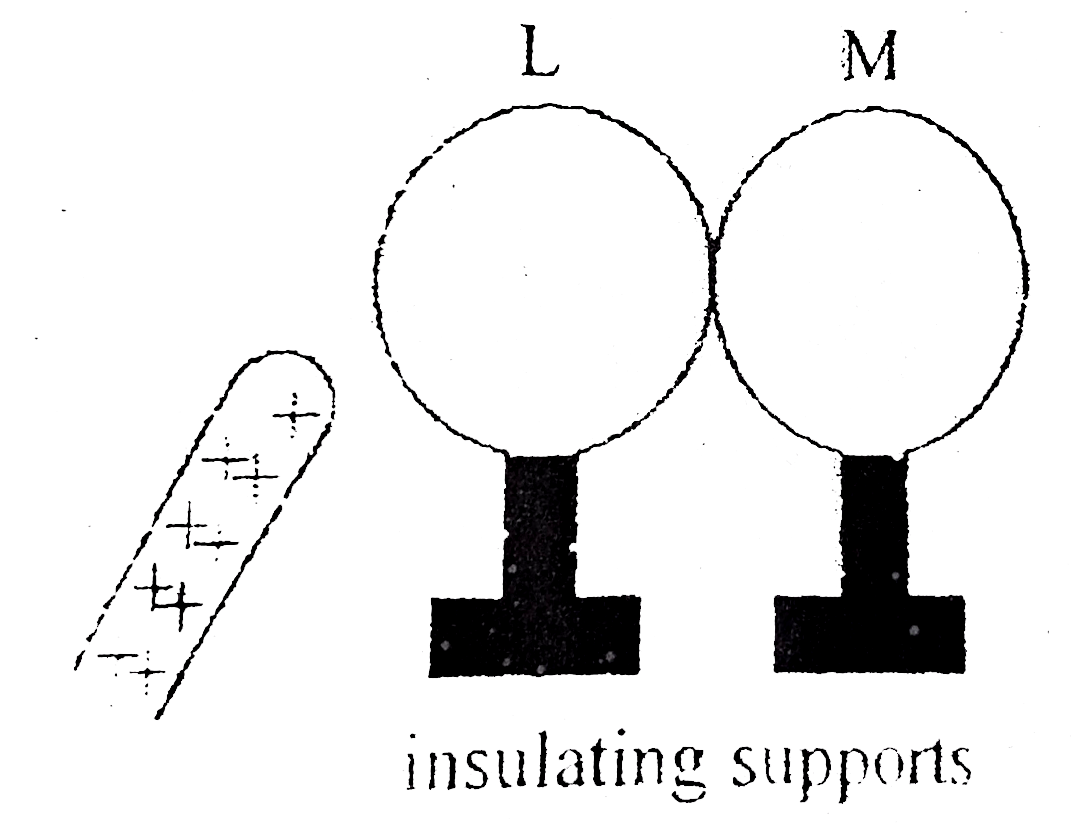Two metallic sphere A and B kept on insulating stand are in contact with each other. A positively charged rod P is brought near the sphere A as shown in the figure. The two spheres are separated from each other , and the rod p is removed. What will be the nature of charges on sphere A and B ?
(##U_LIK_SP_PHY_XII_C01_E08_035_Q01.png" width="80%">
Charge on sphere A will be negative but charge on sphere B will be positive as shown in adjoining
Topper's Solved these Questions
- ELECTRIC CHARGES AND FIELDS BOOK - U-LIKE SERIESCHAPTER - ELECTRIC CHARGES AND FIELDS EXERCISE - SHORT ANSWER QUESTIONS
29 Videos
- ELECTRIC CHARGES AND FIELDS BOOK - U-LIKE SERIESCHAPTER - ELECTRIC CHARGES AND FIELDS EXERCISE - LONG ANSWER QUESTIONS -I
30 Videos
- ELECTRIC CHARGES AND FIELDS BOOK - U-LIKE SERIESCHAPTER - ELECTRIC CHARGES AND FIELDS EXERCISE - ASSERTION-REASON TYPE QUESTIONS
5 Videos
- DUAL NATURE OF RADIATION AND MATTERBOOK - U-LIKE SERIESCHAPTER - DUAL NATURE OF RADIATION AND MATTEREXERCISE - SELF ASSESSMENT TEST SECTION-C (VERY SHORT ANSWER QUESTIONS)
3 Videos
- ELECTROMAGNETIC WAVESBOOK - U-LIKE SERIESCHAPTER - ELECTROMAGNETIC WAVESEXERCISE - SELF ASSESSMENT TEST (SECTION C)
1 Videos
Similar Questions
Write IUPAC name :
" "(##U_LIK_SP_CHE_XII_C13_E08_056_Q01.png" width="80%">
View SolutionA metal sphere is kept on an insulating stand. A negatively charged rod is brought near it , then the sphere is earthed as shown. On removing the earthing, and taking the negatively charges rod away , what will be the nature of charges on the sphere? Give reason for your answer.

View Solution
Knowledge Check
Two uncharged metal spheres, L and M, are in contact A positively charged rod is brought close to L, but not touching it, as shown. The two spheres are slightly separated and the rod is then withdrawn. As a result:
 AL is positive and M is negativeBboth spheres are positiveCboth spheres are negativeDL is negative and M is positive
AL is positive and M is negativeBboth spheres are positiveCboth spheres are negativeDL is negative and M is positiveABC is an equilateral triangle. Charged of +q are placed at each corner. The electric field at O will be
(##U_LIK_SP_PHY_XII_C01_E04_006_Q01.png" width="80%">A14π∈0.qr2B14π∈0.q®C0D14π∈0.3qr2A positively charged body 'A' has been brought near a neutral brass sphere B mounted on a glass stand as shown in the figure. The potential of B will be :
 AZeroBNegativeCPositiveDInfinite
AZeroBNegativeCPositiveDInfinite
Show s tracks of three charged particles in a uniform electrostatic field.Give the signs of the three charges. Which particle has the highest charges to mass ratio?
(##U_LIK_SP_PHY_XII_C01_E01_014_Q01.png" width="80%">
View SolutionShows the electric field lines around three point charges A,B and C.
(a) Which charges are positive ?
(b) Which charge has the largest magnitude? Why?
(##U_LIK_SP_PHY_XII_C01_E09_005_Q01.png" width="80%">
View SolutionA positively charged body 'A' has been brought near a neutral brass sphere B mounted on a glass stand as shown in the figure. The potential of B will be :

View SolutionThree small charges of equal magnitude and same sign lie on the circumference of a circle forming an equilateral triangle. What is the value of electric field at the centre of circle ?
(##U_LIK_SP_PHY_XII_C01_E09_019_Q01.png" width="80%">
View SolutionWhat is the net flux of the uniform electric field of Question 1.15 through a cube of side 20 cm oriented so that its faces are parallel to the coordinate planes?
(##U_LIK_SP_PHY_XII_C01_E01_016_Q01.png" width="80%">
View Solution
